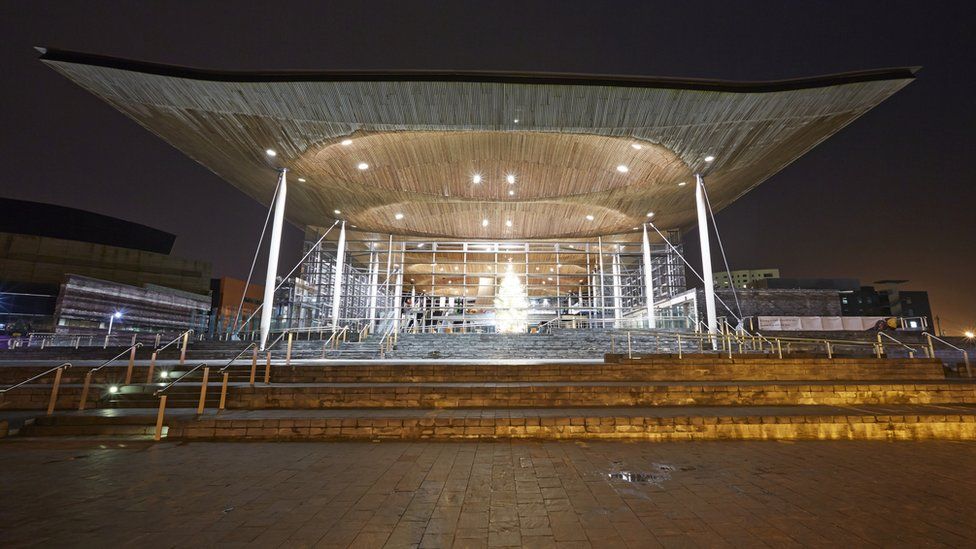
Plans for more Welsh politicians have the backing of Plaid Cymru but are opposed by the Welsh Conservatives
By David Deans
BBC Wales political reporter
Estimates for the cost of electing 36 more politicians to the Senedd – likely to be more than £12m a year – are to be published for the first time later.
Labour ministers will publish their plans to expand the Welsh Parliament, including more politicians and a new voting system, on Monday morning.
The changes, if ready in time, will take effect at the 2026 election.
The plans have the support of Plaid Cymru but are opposed by the Welsh Conservatives, largely on cost grounds.
Up until now the Welsh government has not put a price tag on the reforms, which were drawn up between First Minister Mark Drakeford and Plaid Cymru’s former leader Adam Price last year.
On Monday, the Senedd will see the legislation it will need to pass to agree the changes, which will increase the number of Senedd members from 60 to 96.
If passed, the expansion in Senedd members will come shortly after the number of Westminster MPs is cut in Wales from 40 to 32, although the two decisions are not linked.
Earlier figures from 2020 suggested an extra 30 Senedd members would cost around £12m extra a year. The budget of the Senedd stands at about £67m, while the cost of the Welsh government is roughly £20bn.
The costings, expected to be published alongside the legislation, have been drawn up following a request by Mr Drakeford to the Senedd.
Earlier in the year the Senedd refused a BBC Wales attempt to obtain the figures through a Freedom of Information request.
It said the figures were “intended to be treated confidentially”, and that development of the policy had to take place in a “safe space” away from external challenge.
In a list of reasons, officials said releasing the information before the legislation was introduced could “create concerns, whether within the wider public or media”.
The response said it was also in the public interest “to avoid the potential for damage to the relationship between Welsh government” and the Senedd Commission, which runs the parliament.
What could change under the proposals?
Under the changes the electoral system would be completely replaced. Voters would get one vote, instead of the two they have now, with a choice of party lists rather than candidates.
There would be 16 constituencies, with six Members of the Senedd (MSs) elected in each.
The system used would be designed to elect candidates based on the proportion of votes they receive in the constituency.
Meanwhile the constituencies themselves would be based on seats planned for the next Westminster general election.
It is expected that election candidates would be required to live in Wales.
The government will need the support of two thirds of the Senedd for the changes to be passed.
Image source, Getty Images
Mark Drakeford drew up plans for a 96-seat Senedd last year
Plans for gender quotas on party lists – part of the Drakeford-Price agreement – will not be published on Monday.
The Welsh government has separated quotas from the rest of the plans because of fears it could be subject to legal challenge, amid claims it was not in the Senedd’s powers to pass such a law.
Calls for more politicians in Cardiff Bay stretch back to the years of the assembly.
Backers have argued that the growing responsibilities of the Welsh Parliament means there is an increasing and difficult to manage workload on Senedd members to scrutinise ministers and the laws they want to pass.
Since 2011 the parliament has been able to pass its own laws in areas where is has control, such as health and education.
Meanwhile ministers have gained tax raising powers which are also scrutinised by the Senedd.
An expert panel report in 2017 said the Senedd needed an extra 20 to 30 members.
The Welsh Conservative spokesman on the constitution, Darren Millar, said: “The Welsh government should be focused on addressing unacceptable NHS waiting times, poor standards in schools and the lacklustre performance of the Welsh economy, not wasting time, energy and taxpayers’ money developing yet more legislation on Senedd reform.”








